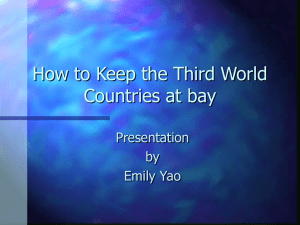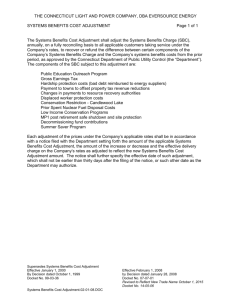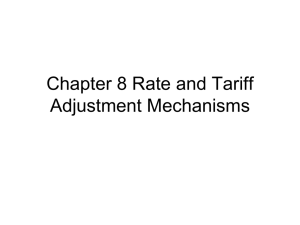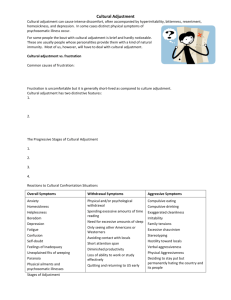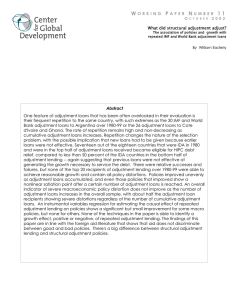Paper n°5 (vnd.ms-powerpoint, it, 300 KB, 4/16/13)
advertisement
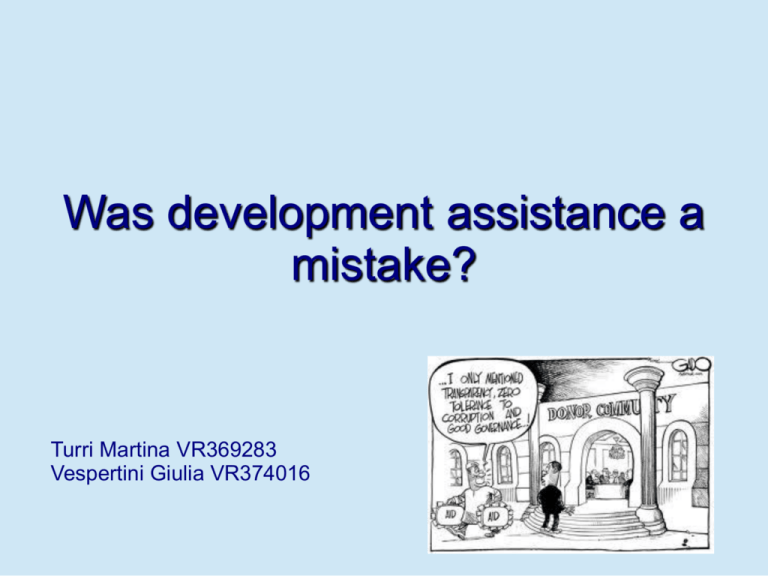
Was development assistance a mistake? Turri Martina VR369283 Vespertini Giulia VR374016 What is development assistance? It's financial aid given by governments and other agencies to support the economic, environmental, social and political development of developing countries. It is distinguished from humanitarian aid by focusing on alleviating poverty in the long term, rather than a short term response. It is the combination of money, advice, and conditions from rich nations and international financial institutions like the World Bank and International Monetary Fund designed to achieve economic development in poor nations. This is broader than the usual definition of “foreign aid,” including such categories as structural adjustment loans, or even repeated stand-by loans from the IMF to low income countries at concessional rates. The World Health Organization (WHO) uses the term development cooperation to express the idea that: a partnership should exist between donor and recipient, rather than the traditional situation in which the relationship was dominated by the wealth and specialized knowledge of one side. How is it structured nowadays? Aid may be: Bilateral, given from one country directly to another; Multilateral, from the donor country to an international organisation (World Bank or the United Nations Agencies) which then distributes it among the developing countries. The proportion is currently about 70% bilateral 30% multilateral. In more than fifty years $2.5 trillions have been spent in development assistance. How is it structured nowadays? Government sources (as official development assistance ODA), provide for 80-85% of developmental aid. Private organisations ("non-governmental organizations" NGOs, foundations and other development charities), provide for the remaining 15-20%. In addition, remittances received from migrants working or living in diaspora form a significant amount of international transfer. Some governments also include military assistance in the notion "foreign aid", although many NGOs tend to disapprove of this. How is it structured nowadays? Government sources (as official development assistance ODA), provide for 80-85% of developmental aid. Private organisations ("non-governmental organizations" NGOs, foundations and other development charities), provide for the remaining 15-20%. In addition, remittances received from migrants working or living in diaspora form a significant amount of international transfer. Some governments also include military assistance in the notion "foreign aid", although many NGOs tend to disapprove of this. Was it a mistake? It could have been a mistake for mainly three assumptions, on which the development assistance was based: 1. We know what actions achieve economic development; 2. Our advice and our money will make those correct actions happen; 3. We know to which individuals “we” and “our” refer. 1. We know what actions achieve economic development Most of the economists have been convinced to know how to achieve economic development. But the ways to achieve development have been changing over time. 1. We know what actions achieve economic development 1950-70: development is compared to economic growth What was expected What really happened This strategy focused on raising the rate of investment to GDP, including both public investments (roads, dams, irrigation canals, schools, electricity) and private investments. Public investments were much more as the states wanted to ensure that the countries would be provided with the right things. Unfortunately, the debts accumulated to finance these investments turned out not to be repayable, so there were two debt crises in the 1980s. The countries entered into a long process of rescheduling and writing off. 1. We know what actions achieve economic development 1980-90, loans to finance structural adjustment What was expected What really happened Attention on how development should be done shifted away from mobilizing and guiding capital accumulation toward the success of the East Asian tigers, who combined export orientation and macroeconomic stability. Low income countries had little or no growth, the loans couldn’t be repaid, and the low income debt crisis stretched out into the new millennium. Every year there was a new wave of debt forgiveness (e.g. the 100 percent cancellation of the structural adjustment loans and other official debts in the Multilateral Debt Relief Initiative of 2006). This became the inspiration for structural adjustment packages of the IMF and World Bank and the “Washington Consensus,” which called for removing price distortions, opening to trade, and correcting macroeconomic imbalances (mainly budget deficits). The slogan of the new wave was “adjustment with growth.” Middle income countries of Latin America, had for the most part adjustment and debt repayment, but little growth compared to expectations in the 1990s. The hope that the “East Asian miracle” could be replicated elsewhere with the same policies proved illusory. 1. We know what actions achieve economic development 2000-2010, The “Second Generation” reforms What was expected What really is happening Made by the “Washington Consensus”. They stressed the importance of property rights, contract enforcement, democratic accountability, and freedom from corruption. An alternative could be Sachs’ emphasis on making the right investments in things poor people need, which is really a throwback to the First Generation of planned investments. Rapidly growing countries like India, China, and Vietnam have already exposed the weaknesses of the new approach. 1. We know what actions achieve economic development Conclusions: We can say that each shift to a new approach to the development was determined more by missing elements, rather than wrong elements. All the blame has been on the recipient rather than on the development experts. A lot of these shifts are provoked by broad stylized facts and compelling country examples rather than by formal empirics. In the new millennium, a remarkably broad group of academics and policymakers seem to agree that, after all that, maybe we don’t know how to achieve development. One of them is the World Bank itself:“different policies can yield the same result, and the same policy can yield different results, depending on country institutional contexts and underlying growth strategies.” 2. Our advice and money will make those correct actions happen The top quarter of aid recipients received 17% of their GDP in aid over the past 42 years, yet also had near-zero per capita growth. The cases of Ghana, Uganda and Mozambique were cases of recovery after steep collapse, and depend on rapid growth episodes that usually prove to be temporary. The cases of rapid growth currently most celebrated -India, China and Vietnam- receive little aid as percent of their GDP. 2. Our advice and money will make those correct actions happen The early expectations that aid would rise growth failed to pay attention to elementary economics a lump-sum transfer does not change the incentives at the margin to invest in the economy. P. Bauer (1976): “any poor country where incentives to invest are attractive doesn’t need aid, while a poor country without incentives to invest will not have aid go into investment.” 2. Our advice and money will make those correct actions happen Nor was there much better news on development assistance changing the policies that were supposed to raise growth. W.Easterly (2005): structural adjustment lending also had no effect on the kind of macro policies and price distortions that it was supposed to correct. P.Van de Walle (2001, 2005): African countries did little reform in response to structural adjustment packages or aid , and aid may have even undermined policy reform. 2. Our advice and money will make those correct actions happen So, there was a general worldwide trend towards better policies, but the degree of movement across countries was not correlated with the intensity of aid or structural adjustment lending in those countries. And there was an insufficient attention in aid agencies to the political incentives facing recipient governments: large aid flows can result in a reduction of governmental accountability because governing elites no longer need to ensure the support of their publics and the assent of their legislatures when they do not need to raise revenues from the local economy, as long as they keep the donors happy and willing to provide alternative sources of funding. 2. Our advice and money will make those correct actions happen Empirically, experts have found that aid worsens democracy, bureaucratic quality, the rule of law and corruption. Unlike most market transactions, the recipient of the aid goods has no ability to signal their dissatisfaction by discontinuing the trade of money of goods. With little or no feedback from the poor, there is little information as to which aid programs are working. Whit many aid agencies in each country, with development of the country depending on many other factors besides aid agencies, and with inability to map actions to development, it’s hard to hold an individual agency accountable for a good or bad development outcome. 3. We know who “we” are The problem is to indentify who are the subjects taking responsability for world poverty. World Bank or UN officials? National government leaders? -The expert tradition is so strong that the WB’s response to the failure of expert analysis on how to achieve development is to intensify the use of expert analysis on how to do that: “we” have to be cognizant of country specificities and need of more economic analysis and rigor to policy making. -On the other hand, economists should not find so hard to take the idea of a spontaneous bottom-up order emerging out of the decentralized actions of many actors. Institutions may emerge much more from the social norms and spontaneous arrangements of many actors than from diktat of some expert from above. Conclusions -We don’t know what actions achieve development, our advice and aid doesn’t make those actions happen and we are not even sure who “we” are that is supposed to achieve development. -It doesn’t necessarily follow tha foreign aid should be eliminated. Foreign aid could finance piecemeal steps aimed at particular tasks for which there is a huge demand (more clean water, build roads, provide scholarships). -The experts should focuse their analysis on problems such as inflation stabilization, financial regulation, or red tape facing business. Bibliografy Bauer P.T. 1976. Dissent on Development: Studies and Debates in Development Economics. Cambridge, MA: Harvard University Press. Boone, Peter, 1996. "Politics and the effectiveness of foreign aid," European Economic Review, vol. 40(2), pages 289-329, February. Dixit, Avinash K. "Evaluating Recipes for Development Success." Paper presented at the World Bank DEC Lectures conference, April 21, 2005. This version June 2005. Djankov, Simeon, García Montalvo, José and Reynal-Querol, Marta, "The Curse of Aid" (March 2006). Available at SSRN: http://ssrn.com/abstract=893558 Easterly, William. "What did structural adjustment adjust? The association of policies and growth with repeated IMF and World Bank adjustment loans" Journal of Development Economics 76 (2005), 1-22. Knack. S. and A. Rahman. 2004. "Donor Fragmentation and Bureaucratic McKinsey Global Institute, The Productivity Imperative: Wealth and Poverty in the Global Economy, Edited by Diana Farrell, Harvard Business School Press, Cambridge MA, 2006 Rodrik, Dani. GOODBYE WASHINGTON CONSENSUS, HELLO WASHINGTON CONFUSION? Harvard University, January 2006 Sachs, Jeffrey D. The End of Poverty: Economic Possibilities for Our Time. Penguin: New York. 2005. Svensson, J. 2003. "Why Conditional Aid Doesn’t Work and What Can Be Done About It?”, Journal of Development Economics, 70 (2), 381-402. van de Walle, Nicolas. 2005. Overcoming Stagnation in Aid-Dependent Countries. Washington, DC: Center for Global Development. World Bank, 2005, Economic Growth in the 1990s: Learning from a Decade of Reform,Washington DC
